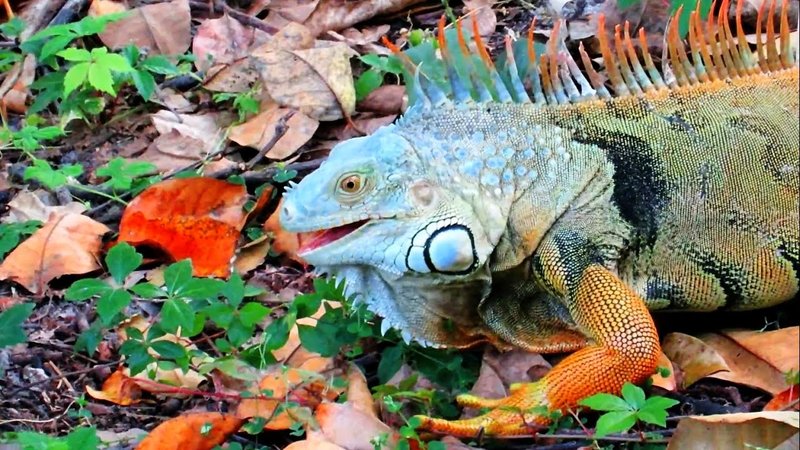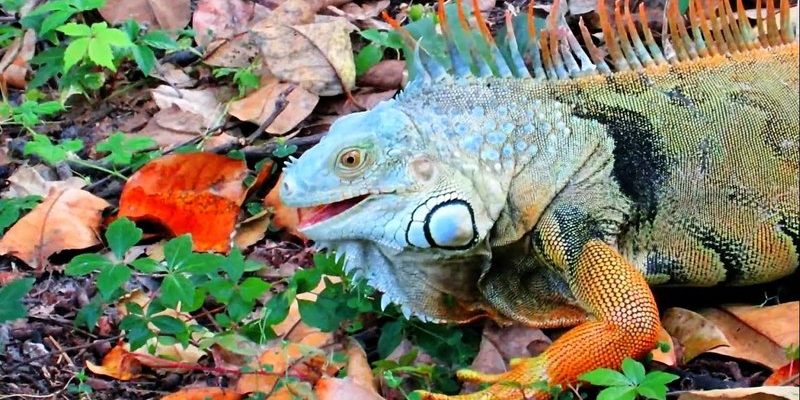
Think of a green iguana’s eating habits as a balancing act between being a picky eater and an opportunistic grazer. They’re primarily herbivores, which means they prefer munching on plants, but their diet is actually more varied than you might think. Let’s unpack this a bit more and dive into what green iguanas eat and how they hunt for their food.
Understanding the Diet of Green Iguanas
Green iguanas are primarily herbivores, which means their diet mainly consists of plants. You might be wondering, “What types of plants do they actually go for?” Well, these iguanas enjoy a range of leafy greens, fruits, and flowers. They often feast on items like hibiscus, dandelions, collard greens, and even some fruits like mango and bananas.
But here’s where things get interesting: green iguanas are *selective eaters.* They don’t just eat anything that looks green. They tend to choose fresh leaves and tender shoots that are high in moisture and nutrients. This preference helps them maintain their health and energy levels. Just think about it: choosing fresh salad over wilted greens is pretty relatable, right?
Common Foods in a Green Iguana’s Diet
In the wild, a green iguana’s menu can vary depending on what’s available in its habitat, which is typically tropical rainforests. However, their preferred items often include:
- Leafy Greens: Collard greens, mustard greens, and kale.
- Fruits: Mango, banana, and papaya.
- Vegetation: Flowers like hibiscus and clover.
It’s essential for pet owners to replicate this diet as closely as possible to keep their iguanas healthy. Offering a variety of these fresh foods helps avoid dietary deficiencies. Plus, some iguanas can be a bit picky, so it might take some trial and error to find what they love best.
How Green Iguanas Hunt for Food
When we think of hunting, we might picture predators on the prowl, but for green iguanas, hunting is a much more relaxed affair. Instead of chasing down prey, they use a more leisurely approach to find their meals. They’re *browsers,* not hunters in the traditional sense, which means they graze and pick food as they go.
You might see them climbing trees or lounging on branches, scanning their surroundings for tasty foliage. This isn’t just a lazy approach; it’s strategic. By positioning themselves higher up, they can access more food while avoiding ground-based predators. It’s like eating at a buffet that’s only open to a select few!
The Role of Climbing in Their Feeding Behavior
Climbing is an essential part of how green iguanas *forage* for food. These agile reptiles are excellent climbers thanks to their strong limbs and sharp claws. They often use their climbing skills to reach the freshest leaves and fruits that are out of reach for many other animals.
In the wild, their climbing abilities also help them escape potential threats. By staying off the ground, they have a better chance of spotting predators. This behavior is both a hunting technique and a survival strategy, making them well-adapted to their environment.
Hydration and Its Importance
Staying hydrated is just as important as what they eat. In their natural habitat, green iguanas hydrate mainly through the plants they consume, but they also drink water when available. This aspect of their diet can be often overlooked, but it’s crucial for their health.
You might also notice that in captivity, giving them access to a shallow water dish can encourage drinking. This extra hydration helps keep their skin healthy and supports their overall bodily functions. It’s like ensuring you have enough water while enjoying your meal!
Impact of a Poor Diet
Providing a poor diet can lead to serious health problems for green iguanas. Many owners mistakenly feed them too much protein or animal products, which can cause metabolic issues. To keep your iguana healthy, it’s best to stick to their preferred plant-based diet.
A lack of proper nutrients can also lead to conditions like metabolic bone disease. This condition can occur when iguanas don’t get enough calcium or UVB lighting. It’s alarming to think about how something as simple as diet can change the life of these creatures.
Tips for Feeding Your Green Iguana
If you’re taking care of a green iguana, here are some tips to ensure they’re eating well:
- Variety is Key: Offer different types of greens and fruits to keep their diet interesting.
- Freshness Matters: Always provide fresh, organic options when possible to boost their nutrient intake.
- Avoid Processed Foods: Stick to natural foods—processed items can be harmful to their health.
Feeding them the proper diet not only keeps them healthier but also makes for a happier iguana. You’ll likely see them more active and vibrant when they’re well-nourished!
Green iguanas are fascinating creatures with unique dietary needs and hunting methods. By understanding what they eat and how they find their food, you can appreciate the complexities of their lives a bit more. Remember, the key to a happy, healthy iguana is providing a diverse and nutritious diet. Whether in the wild or as a pet, these incredible reptiles showcase nature’s intricate balance in their eating habits. So, the next time you see an iguana lounging around, think about the journey it takes to find its meals—an adventure you now know has a lot more going on than meets the eye!

